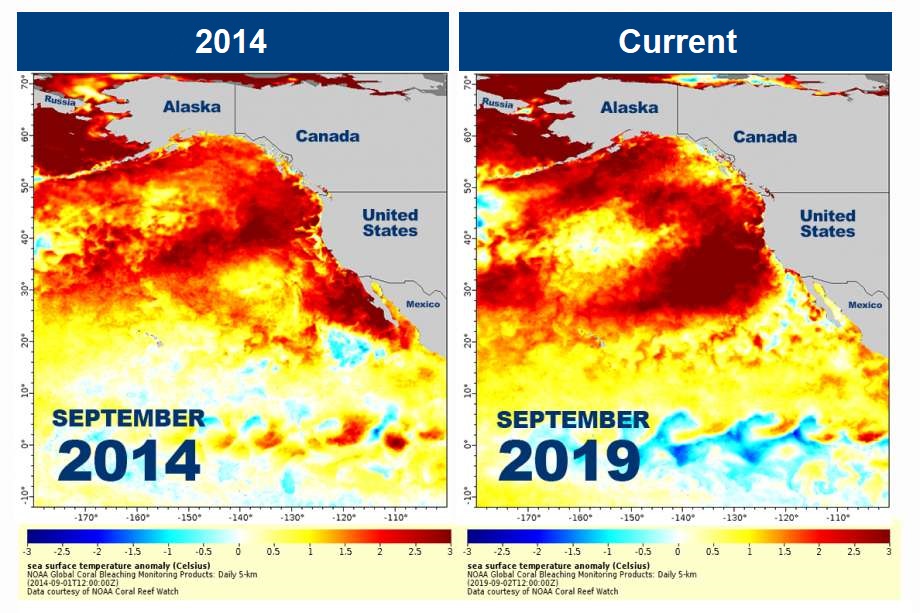The blob strikes back! How data can help us tackle ocean heat waves
A massive blob of warm water appeared in the Pacific this year along the West Coast of the US and Canada. Marine heat waves like this seem to be on the rise, just as they are on land. How should we react?
T
here’s a lot we don’t know about how climate change will unfold. Unexpected events will occur, and when they do we will need to adapt and learn from those experiences. Here’s a story about one of these climate surprises: the “warm blob” in the Pacific Ocean.
Scientists observed a warm blob of water forming off the U.S. West Coast in September, five years to the month after a similar blob wreaked havoc on marine ecosystems and fisheries in this region. It’s enormous, stretching from southern California all the way to Alaska. When the first blob formed in 2014, whales started to feed in nearshore waters and got entangled in fishing gear. Thousands of young sea lions stranded themselves on beaches. A huge harmful algal bloom formed, contaminating shellfish. Multiple fishery disasters were declared.
Early warning
Forecasters say the 2019 blob could break up and dissipate harmlessly. But — because they are scientists — they also say that if the cold water upwelling from deeper layers of the oceans slackens, the blob could expand instead. So, there is a lot of uncertainty. The good news is that a new monitoring system is now in place that actually detected the warm blob while it was forming this year. This could help natural resource managers and the fishing industry plan and adapt in real-time.
Even better, the National Oceanic and Atmospheric Administration has convened a group of experts to interpret the monitoring data and provide advice to working groups of fishermen, fishery managers and others that formed along the West Coast in response to the first blob.
This illustrates the first steps toward responsible adaptation to changes in the ocean, some of which may become more frequent or intense as a result of climate change. Marine heat waves (the scientific term for warm blobs) seem to be increasing in intensity, perhaps as part of a long-term increase in ocean temperature as the ocean absorbs heat from the atmosphere.

We must all continue to work on reducing greenhouse gas emissions and increasing natural carbon sinks like forests and soil — and also the ocean’s biological carbon pump — to slow global warming down in order to reduce impacts and costs. But the earth is already warming, and we are locked into even more warming no matter what we do because of past emissions and reductions in carbon sinks, so we have to work toward solutions within our current reality.
First steps
The best way to do that is to monitor, interpret data, plan ahead and adapt. Even the best monitoring data are useless unless people who understand the data and ocean ecosystems interpret them and provide guidance to stakeholders and managers. And then, of course, managers have to promulgate regulations that take projected changes in the ocean into account; stakeholders have to comply with the regulations; and the regulations have to be evaluated to see if they work so they can be adjusted as needed.
These are the basic tenets of effective fisheries management — monitoring, data interpretation, science-based regulations, strong accountability measures and adaptive decision-making. This will remain the recipe for success in the face of climate change, but the science, as well as the management goals and benchmarks, will need to be updated to reflect changing ocean conditions.
Along the West Coast, the monitoring system is in place, and experts have been convened to interpret the data. It remains to be seen whether the other elements for successful adaptation will be put into place. Will resource managers take the monitoring data into account when setting regulations? Will stakeholders buy in to those regulations and comply with them? Will the regulations be regularly evaluated in order to make them better and more responsive to more changes in the ocean? The stakes are high, given the wide-ranging impacts of warm blobs.
The ideas presented in this article aim to inspire adaptation action – they are the views of the author and do not necessarily reflect those of the Global Center on Adaptation.